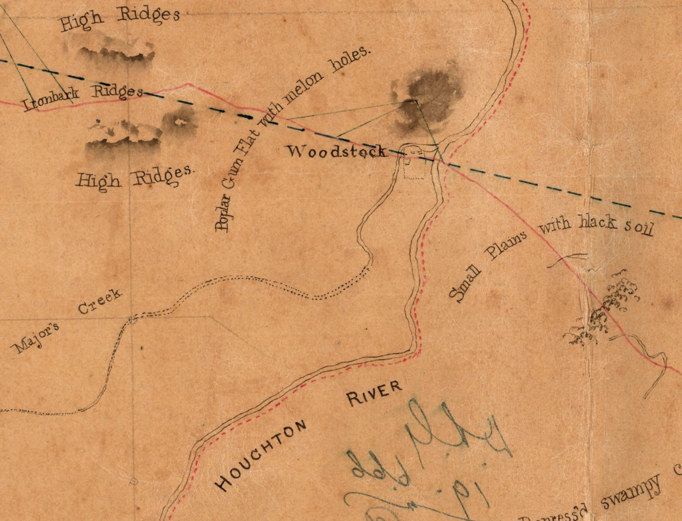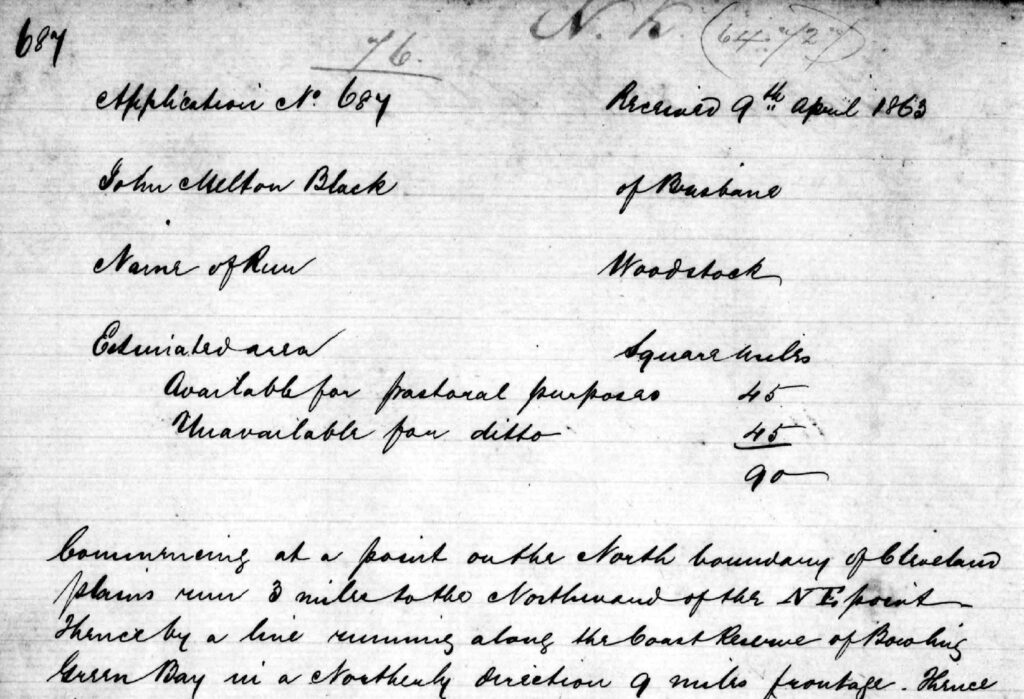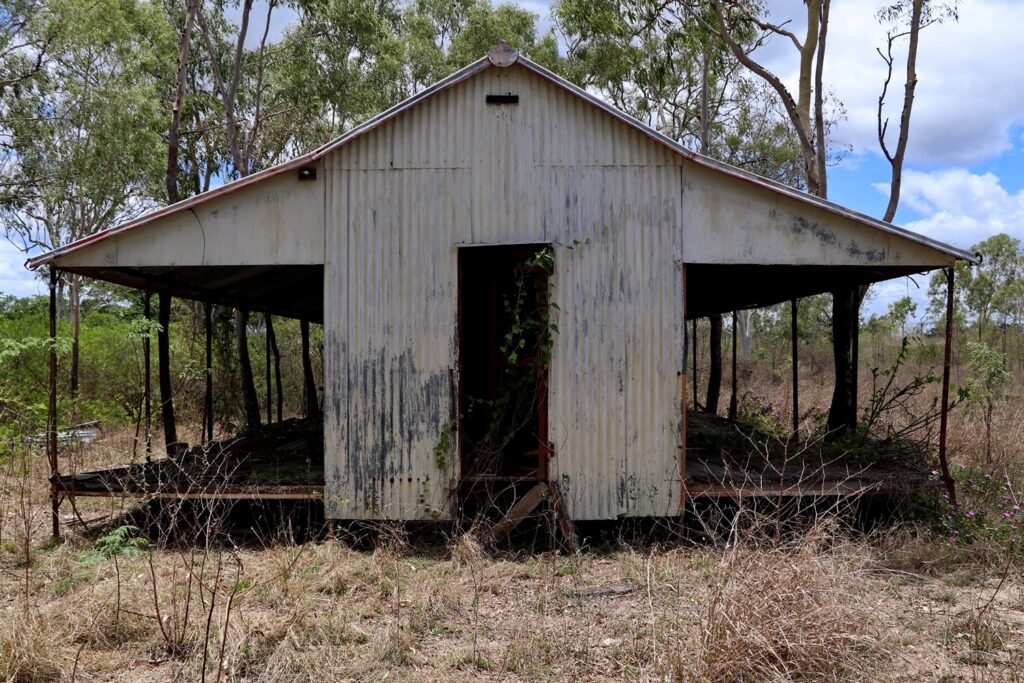Woodstock Station
There are a few ruinous wooden buildings overgrown with creepers situated on the bank of the Haughton River, just where it skirts the south-western foothills of the grand but isolated Mount Elliot group: splendid clumps of bamboo wave their long branches mournfully above them, and the wind sighs sadly through their stems as if in memory of the merry days gone by, when Woodstock station, for such its name, was in the zenith of its prime. The cattle yards are empty, the huts deserted except by the lizard and the bandicoot, and everything speaks of the decay which so rapidly over-takes a place which man has left to the mercy of the elements.1
This description of Woodstock Station was written in 1890, at a time when the local beef market was depressed but which could well apply to the present-day appearance of the abandoned site located at the confluence of the Haughton River and Majors Creek. The application for the run was first made in 1863 by John Melton Black as part of an ambitious commercial strategy to own a broad swathe of pastoral properties on the coast and hinterland. The Woodstock head station was to become the base for the surrounding runs comprising Cleveland Plains, Cintra, Magenta, Woodstock, Repulse Plains, Stanley Plains, Wyoming and Halifax Plains. These in turn were connected to Black’s considerable holdings which straddled the Burdekin and Fanning Rivers and extended as far as the future site of Charters Towers.2
The need to fulfil the government stocking requirements for all these runs left Black financially stretched and some of these properties were mortgaged to various parties. Sometime early in 1864 this came to the notice of a prominent Sydney capitalist, Robert Towns, to whom Black unveiled his plans for development. Towns was ‘very impressed with the preliminary surveys and the extent of his pastoral holdings – “a small principality”, he called it’.3
In a short time, the various properties were transferred into Towns’ name whilst both he and Black became equal partners in the newly found enterprise of J M Black and Co. Towns was almost 40 years Black’s senior, but he was well used to working with young men of talent and spirit and had no difficulty working with the young adventurers – the ‘Kennedy Men’ 4
← Black’s application for the Woodstock run in 1863
Overarching this pastural empire was the need to access a useable year-round port, without which the produce from the runs could not be moved to market. The recent wet season had seen a major flood on the Burdekin which destroyed the Landing – recently established for such transport. The flood also meant that the nearest port of Bowen was entirely cut off for months. It was perhaps the thrall of the discovery of a new port that so inspired Towns enthusiasm. One account tells us that:
At this time (1864) Mr Andrew Ball was manager of Woodstock station, and at the instance of Mr Black, he set out in April of that year to explore the unknown country lying immediately to the northward of the North-westerly spurs of Mount Elliott. All the produce of the stations was then shipped at what was termed ‘The Landing’, on the anabranch of the Burdekin. That the sheep on the Fanning Downs station might have a share of the luxuriant feed of the Burdekin Delta and that the carriage of their wool might be saved, the flocks after the first shearing, were annually driven to Jarvisfield, and driven back to the run after being relieved of their fleeces. 5
And another account tells us that Woodstock was:
…. a festive spot in 1864, however, when young Andrew Ball was manager. It was then the ultima thule of squatterdom and beyond it to the north was an unknown land. The blacks who were let on to the station, on being questioned, told of a river which ran into the sea the other side of Mount Elliot, the size and permanency of which lost nothing in the telling, nor by the fact that the thought of its existence lay rankling in men’s minds until they longed to reach it. The story came to the ears of the ever-restless Black, who at once jumped at the idea that here perhaps was the opportunity he sought – the site for his Arcadian port. At once he gave Andrew Ball instructions to wander forth into that howling wilderness and spy out the land for himself, so in April of 1864 that gentleman saddled up, and escorted by one white man and two black boys he started off on his voyage of discovery, taking the coast side of the range instead of the inland route. 6

Woodstock Station – the ultima thule of squatterdom in 1864 as described above, allegedly drawn by Mark Watt Reid in 1864. The drawing illustrates himself standing on the verandah of his house which he describes elsewhere as ‘very comfortable, I have a sitting room and bedroom and a very large verandah all to myself except for the periodical visits of Mr Ball (the super)….I live pretty well, any quantity of milk and eggs and now and then a treat of wild fowl and fish.’ © Townsville City Council
The remainder of this story belongs elsewhere but suffice to say that the importance of the ‘discovery’ of Cleveland Bay as a sheltered anchorage quickly reached Robert Towns, who as chairman of the Bank of New South Wales wrote to his secretary in September 1864 that he:
was glad you started the Bowen (bank) branch…. you must be prepared for another further north in a few months – a new discovery on our run which will knock the wind out of Bowen and Rockingham Bay also.7
1 Illustrated Sydney News, Thursday 23 January 1890, page 25
2 Black to Gold 2014 Michael Brumby p. 37
3 Townsville’s Neglected Founder: The Mysterious Mr Black Dr Dorothy Gibson-Wilde.
SirRobert Philp Lecture Series 2009 p. 107
4 Draft of Unpublished Biography of Robert Towns (manuscript) James Manion
5 The Townsville Herald Townsville Past and Present 24th December 1887 p. 29
6 Illustrated Sydney News, 23 January 1890, page 25
7 Ibid Brumby 2014 p. 40
More pictures can be seen here.……..Woodstock Station



